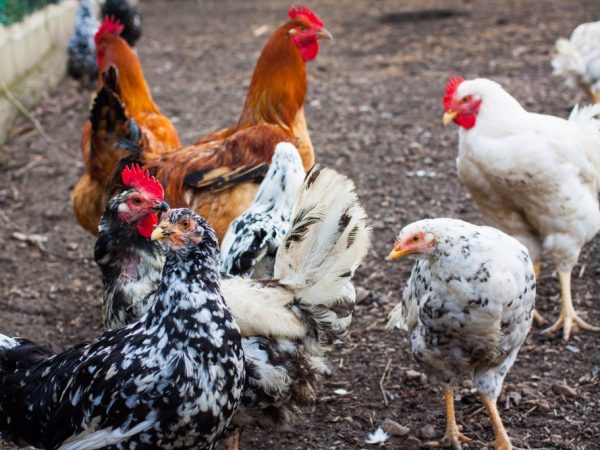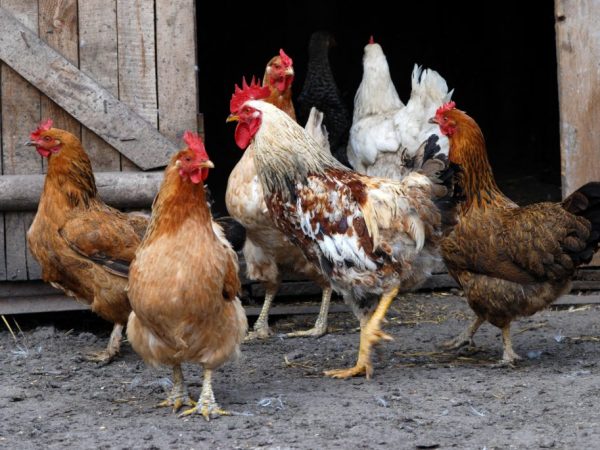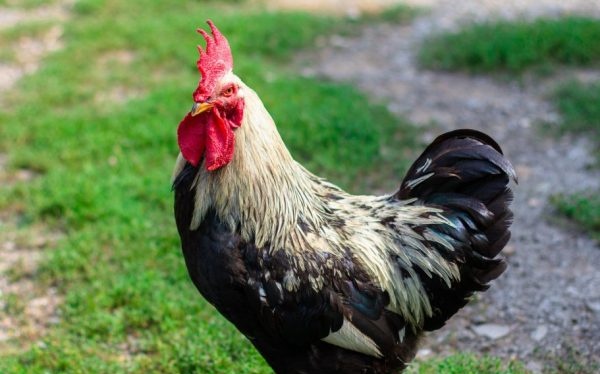Description and breeding of Yurlov vociferous chickens
Yurlov's vociferous chickens were obtained as a result of crossing of fighting and local breeds. They have a strong body, strong bones and belong to the meat and egg group.

Description and breeding of Yurlov vociferous chickens
Features of the breed
The stocky and massive Yurlovsky chickens have the following characteristics:
- strong body;
- the head is wide with a rounded occiput;
- leaf-shaped crest, horn-shaped or nut-shaped;
- thanks to the well-developed superciliary arches, the birds have a somewhat formidable and proud appearance;
- medium-sized earrings;
- scarlet earlobes;
- the beak is small, yellow;
- tail of medium length, fluffy, at right angles to the back;
- plumage can be different - black, silver-black, dark yellow with red elements;
- paws yellow, brown or orange;
- both hens and cockerels have a long neck, which gives them a stateliness;
- in males, the area of the lower leg and thighs is more developed and pronounced.
Character
A farmer who wants to acquire this breed needs to know that the character of these chickens is quite complex. They are characterized by aggression, impulsiveness and irascibility. Regardless of gender, adults react negatively to the appearance of strangers in the herd.
Therefore, the breeder needs to seriously approach the issue of separating individuals and families in order to eliminate the risk of injury in the future.
The second character trait is that the bird sings very loudly. Her scream can be heard within a radius of 25-30 m.
Productivity
The weight of the Yurlovsk hens is impressive - the weight of an adult rooster is 6-6.5 kg, of a chicken - 4-4.5 kg. Sexual maturity does not occur earlier than after 8-9 months. Delayed puberty is due to the large mass and complex process of muscle formation. The egg production indicators are good - one hen can lay from 140 to 190 eggs per year. The average weight of one egg is 70-75 g. The shell is brown, strong.
Almost all females have a developed incubation instinct - almost 100%. Only some individuals lack it.
Advantages and disadvantages
Yurlovskaya breed of chickens includes several advantages:
- good indicators of meat and egg productivity;
- large eggs;
- great taste of meat and eggs;
- high survival rate of chicks and young animals;
- good resistance to many diseases.
Among the disadvantages are:
- increased aggression in roosters;
- belated productivity;
- birds require a lot of space for full growth and development.
Another disadvantage is the increased demand for food ration and high feed consumption.
Where could I buy
You can buy this breed at the Institute of Poultry of Russia, where there are hatching eggs, as well as young animals. Some poultry farmers buy them at poultry exhibitions from quality producers.
The best males for successful breeding can be purchased from breeders at home - in the Lipetsk and Oryol regions.
The best farms producing Yurlovsky chickens: KHF Alekseevskoe, Kurkurovo, LPH Soykinskoe and Ferma.
Conditions of detention

Chickens need a certain temperature regime
The conditions for keeping birds both in winter and in summer are equally important. The main indicators of productivity are the correct temperature, humidity, space and ventilation.
Chicken coop
The optimal temperature regime for birds in the hen house is 12-13 ° С. Daylight hours are at least 13 hours. It is important that there are no drafts in the room, but there must be good ventilation.
They also need space - 0.5 m³ is enough for one individual. Sawdust, straw, peat are used as bedding. Such components are able to quickly absorb moisture. Before laying it, the floor surface is sprinkled with lime, which prevents the development of a fungal infection.
Litter change is carried out at least twice a year. In this case, it is important that it does not get wet, because when wet, the flooring is an excellent environment for the development of necrobacteriosis, coccidiosis and other infections.
Walking yard
The description of the Yurlov breed includes obligatory daily walking, which has a beneficial effect on the productivity of the bird.
For this purpose, a walking yard is equipped, which is fenced with a net or a fence. So the bird will be able to go out into the fresh air at any time and nibble on pebbles, shells or grass.
Feeders and drinkers
The chicken coop should be equipped with feeders and drinkers. For each individual, you need to allocate 10 cm for feeding and 2.5 cm for drinking. The feeders are filled to a third of the volume so that the bird rakes out bulk feed as little as possible. Mineral components - chalk, shell, gravel, limestone are placed in separate containers.
Drinking bowls are of different types - nipple, groove, vacuum. The main requirement is that water should not be spilled and clogged with droppings.
Diet
Proper and balanced nutrition is the key to good productivity. Different poultry feeds are used depending on age.
- Daily supply of peas, soybeans, oats, wheat and corn per rooster - 150 g, for one chicken - 100-120 g.
- In winter, with a lack of vitamins and minerals, ground herbs are added to the main feed once a week. If possible, the bird can be given chopped vegetables and herbs. The optimal norm of vegetables per individual per day is 100 g.
- In addition, chickens require protein, which is found in cottage cheese, maggots, worms, fish and meat.
- During the laying of eggs, hens are introduced into the diet of shells and chalk, which increase the strength of the shell. It is advisable to feed the bird with such components all year round.
- In the summer, greens are given daily. It is also important that the bird drinks a lot of liquid, because from dehydration of the body it becomes lethargic, its productivity and development decreases.
With extreme caution, you need to give the birds sunflower cake and a mash based on boiled potatoes, since chickens, especially without the possibility of walking, quickly get fat on such a feeding.
Molting
Plumage changes usually occur due to changes in age and season. The annual moult in chickens occurs closer to autumn. The period of release from the feather cover helps to cleanse the bird's body of harmful substances and toxins.
At this time, the bird stops laying eggs. The change of feather cover lasts from 4 to 8 weeks.
During this period of life, birds need to be carefully cared for:
- if molt takes place in winter, keep the birds warm;
- the possibility of walking under a canopy on rainy days;
- provide good and balanced feeding.
These conditions shorten the moulting period in chickens, after which they immediately begin to lay.
Breeding features

The rooster is the most important
To get strong and healthy offspring, you must adhere to some rules.
- Completing families is carried out at the rate of 15-20 chickens per rooster.
- Eggs are taken from healthy hens that are in the same flock with the rooster. For incubation, medium-sized specimens are selected, not older than six days with a strong and smooth shell without cracks. The shape should be oval without a pronounced sharpness.
- During the period of egg collection, for hatching chickens, the diet should be balanced and with a high content of vitamins and minerals. It is possible to determine whether the chicken received enough vitamins by the state of the boiled yolk - it should be a rich yellow color.
- After selection, 15-17 eggs are laid under the chicken.
- For incubation, equip a place with a nest. A regular wooden box lined with hay or straw will do. The hatching place should be comfortable - slightly darkened and calm. A feeder and a drinker are placed next to the nest.
- If it is planned to plant several hens, the nests are arranged in such a way that the chickens do not crowd.
Incubation
Many breeders successfully breed Yurlov chickens in an incubator. For this, certain temperature conditions must be provided:
- in the first seven days - 40 ° C;
- second week - 39 ° С;
- the third - 38 ° C;
- the fourth - 36 ° C.
During this time, the eggs are periodically turned over - at least 3 times a day.
Caring for chicks
Yurlovsky chickens are distinguished by intensive growth, but the first clutch from them can be expected no earlier than six months later. Youngsters like a lot of space and outdoor exercise, so after chicks grow up, they should be provided with a good and spacious housing, such as an aviary.
In winter, they need a warm chicken coop, since by their nature they are heat-loving birds. The optimal temperature regime for keeping young stock in winter is 25-30 ° С.
At the age of three to six months, chickens are equipped with special crossbeams and straw perches. The optimum height is about 1 m. There should be no drafts in the room. For the prevention of colds, moss peat is used as bedding, which is able to perfectly absorb moisture.
Fattening
The first time the chicks are offered food after the fluff dries out and they are transferred to a separate place for keeping. The best product is a chopped, boiled chicken egg. Three days later, chopped cereals, minced meat, cottage cheese and maggots are introduced into the diet.
The period from 2-6 months is the most important, because at this time there is an accelerated growth and weight gain by chickens. Therefore, nutrition should be enhanced and with an increased introduction of minerals. The best feeding during this period of life is compound feed.
For the normal functioning of the digestive tract, herbs and vegetables are introduced into the diet.
Possible diseases
This breed is endowed with high immunity against disease, but many breeders believe that preventive measures will not be superfluous.
At an early age, the chicks are vaccinated and subsequently given the proper care described above. This will protect the grown young and adults from infection with ticks, chewing lice and various pathogens.
In young individuals with an excess of infrared rays or a poor diet, curvature of the fingers is observed. To eliminate this problem, it is necessary to improve the diet - to introduce a vitamin-mineral complex into the main food, as well as to optimize the rules of care.
Breeders' opinion
Breeders leave mixed reviews about this breed of chickens:
- Some farmers are unhappy with the low egg production compared to other breeds.
- Others praise, give a positive response and are satisfied with the taste of meat and eggs.
- To increase the productivity of eggs, experienced breeders advise to seriously approach the choice of males. An early chant with a high pitch and short duration is the main signal that such an individual is not suitable for further breeding.


